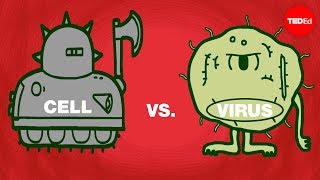(单词翻译:单击)
You're in line at the grocery store when, uh oh, someone sneezes on you.
你在超市里排队,哦,不妙,有个人朝你打了个喷嚏。
The cold virus is sucked inside your lungs and lands on a cell on your airway lining.
感冒病毒被吸到了你的肺里,然后降落在你气管壁上的一个细胞。
Every living thing on Earth is made of cells,
地球上所有的生命都是由细胞组成的,
from the smallest one-celled bacteria to the giant blue whale to you.
从最小的单细胞细菌,到巨大的蓝鲸,到你。
Each cell in your body is surrounded by a cell membrane,
你身体里的每一个细胞都是被细胞膜所包起来,
a thick flexible layer made of fats and proteins, that surrounds and protects the inner components.
那是由脂肪和蛋白质组成的一层即厚又软的物质,包围并保护着细胞内部。
It's semipermeable, meaning that it lets some thing pass in and out but blocks others.
细胞具有半渗透性,意味着它让有些东西自由进出,但阻挡其它的东西。
The cell membrane is covered with tiny projections.
细胞膜上有很多突出的部分。
They all have functions, like helping cells adhere to their neighbors or binding to nutrients the cell will need.
它们都有用处的,比如帮助细胞吸附住临近的细胞,或帮细胞链接上营养物质。
Animal and plant cells have cell membranes.
动物细胞和植物细胞都有细胞膜。
Only plant cells have a cell wall, which is made of rigid cellulose that gives the plant structure.
但是只有植物细胞有细胞壁,当中坚硬的纤维素给植物制造了他的结构。
The virus cell that was sneezed into your lungs is sneaky.
被打喷嚏进你肺里的病毒体是很狡猾的。
Pretending to be a friend, it attaches to a projection on the cell membrane,
它假装是一个朋友,连到细胞膜上的一个突出部分,
and the cell brings it through the cell membrane and inside.
然后细胞让它穿过细胞膜进来。
When the virus gets through, the cell recognizes its mistake. An enemy is inside!
当病毒在里面了以后,细胞认识到它犯的错误。敌人到里面来了!
Special enzymes arrive at the scene and chop the virus to pieces.
特殊的酶赶到现场,把病毒切成数块。
They then send one of the pieces back through the cell membrane,
之后它们把其中的一块放到细胞膜外面,
where the cell displays it to warn neighboring cells about the invader.
这样细胞就可以警示它旁边的细胞:有入侵者。
A nearby cell sees the warning and immediately goes into action.
旁边一个细胞看到了这个警示,立刻开始行动。
It needs to make antibodies, proteins that will attack and kill the invading virus.
它需要制造叫做抗体的、会攻击并杀掉入侵病毒的一种蛋白质。
This process starts in the nucleus.
整个制造流程从细胞核内开始。
The nucleus contains our DNA, the blueprint that tells our cells how to make everything our bodies need to function.
细胞核装有我们的DNA,那是一幅告诉我们细胞怎么制造我们身体所需的一切东西的蓝图。
A certain section of our DNA contains instructions that tell our cells how to make antibodies.
我们DNA的一部分有指示来告诉我们的细胞怎么制造抗体。

Enzymes in the nucleus find the right section of DNA, then create a copy of these instructions, called messenger RNA.
细胞核中的酶找到正确的DNA部分,再制造这些指令的备份,叫做信使RNA。
The messenger RNA leaves the nucleus to carry out its orders.
信使RNA离开细胞核去执行它的命令。
The messenger RNA travels to a ribosome.
信使RNA到了一个核糖体。
There can be as many as 10 million ribosomes in a human cell,
在一个人体细胞里有一千万个核糖体,
all studded along a ribbon-like structure called the endoplasmic reticulum.
都集中在一个叫做内质网的结构上。
This ribosome reads the instructions from the nucleus.
这个核糖体解读来自细胞核的指示。
It takes amino acids and links them together one by one creating an antibody protein that will go fight the virus.
它把氨基酸一个接一个串起来,制造成一个会攻击病毒的抗体蛋白质。
But before it can do that, the antibody needs to leave the cell.
但在那之前,抗体必须得离开细胞。
The antibody heads to the golgi apparatus. Here, it's packed up for delivery outside the cell.
抗体去往高尔基体。在这里,它会被包装起来向细胞外运输。
Enclosed in a bubble made of the same material as the cell membrane,
包在一个由细胞膜物质组成的泡泡里,
the golgi apparatus also gives the antibody directions, telling it how to get to the edge of the cell.
高尔基体也会给抗体指示,告诉它怎么去细胞的边缘。
When it gets there, the bubble surrounding the antibody fuses to the cell membrane.
当它到了那里,包着抗体的泡泡融入细胞膜。
The cell ejects the antibody, and it heads out to track down the virus.
细胞射出抗体,然后抗体去找那病毒。
The leftover bubble will be broken down by the cell's lysosomes and its pieces recycled over and over again.
剩下的泡泡会被细胞的溶体而分解,它的碎片被重复地回收利用。
Where did the cell get the energy to do all this? That's the roll of the mitochondria.
细胞在哪里找来能量去做这些事情?那是线粒体的功能。
To make energy, the mitochondria takes oxygen, this is the only reason we breathe it,
为了制造能量,线粒体吸进氧气,这是我们需要氧气的唯一原因,
and adds electrons from the food we eat to make water molecules.
然后它加入从我们吃的食物中来的电子去制造水分子。
That process also creates a high energy molecule, called ATP which the cell uses to power all of its parts.
这个过程同时制造出一个高能量分子,叫做三磷酸腺苷,为细胞供给能量所用。
Plant cells make energy a different way.
植物细胞通过不同的形式制造能量。
They have chloroplasts that combine carbon dioxide and water
它们有叶绿体,能结合二氧化碳及水,
with light energy from the sun to create oxygen and sugar, a form of chemical energy.
借助从太阳得来的光能产生氧气及糖,为化学能的一种形式。
All the parts of a cell have to work together to keep things running smoothly,
细胞内的所有零件都必须合作,让一切运作顺利,
and all the cells of your body have to work together to keep you running smoothly.
你体内所有的细胞也必须一起工作,使你一切正常。
That's a whole lot of cells. Scientists think there are about 37 trillion of them.
那是一大堆的细胞。科学家认为大约有37万亿个。


